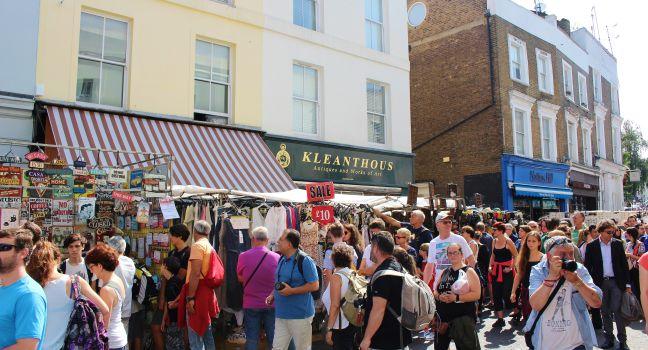The keyword of London shopping has always been "individuality," whether expressed in the superb custom tailoring of Savile Row, the nonconformist punk roots of quintessential British designer Vivienne Westwood, or the unique small stores that purvey their owners' private passions—be they paper theaters, toy soldiers, or buttons. This tradition is under threat from the influx of chains (global luxury, domestic mid-market, and international youth), but the distinctively British mix of quality and originality, tradition, and character remains.
You can try on underwear fit for a queen at Her Majesty's lingerie supplier, track down a leather-bound Brontë classic at an antiquarian bookseller, or find a bargain antique on Portobello Road. Whether you’re just browsing—there's nothing like the size, variety, and sheer theater of London’s street markets to stimulate the acquisitive instinct—or on a fashion-seeking mission, London shopping offers something for all tastes and budgets.
Although it's impossible to pin down one particular look that defines the city, London style tends to fall into two camps: one is the quirky, somewhat romantic look exemplified by homegrown designers like Matthew Williamson, Jenny Packham, Vivienne Westwood, and Lulu Guinness; the other reflects Britain’s celebrated tradition of classic knitwear and suiting, with labels like Jaeger, Pringle, and Brora, while Oswald Boateng, Paul Smith, and Richard James take tradition and give it a very modern twist. Traditional bespoke men's tailoring can be found in the upscale gentlemen's shops of Jermyn Street and Savile Row—there's no better place in the city to buy custom-made shirts and suits—while the handbags at Mulberry, Asprey, and Anya Hindmarch are pure classic quality. If your budget can't stretch that far, no problem; the city's chain stores like Topshop, Zara, and H&M, aimed at the younger end of the market, are excellent places to pick up designs copied straight from the catwalk at a fraction of the price, while mid-market chains like Reiss, Jigsaw, and L.K. Bennett offer smart design and better quality for the more sophisticated shopper.
If there’s anything that unites London’s designers, it’s a commitment to creativity and originality, underpinned by a strong sense of heritage. This combination of posh and rock 'n' roll sensibilities turns up in everyone from Terence Conran, who revolutionized product and houseware design in the ’60s (and is still going strong), to Alexander McQueen, who combined the punk aesthetic with the rigor of couture. You'll see it in fanciful millinery creations by Philip Treacy and Stephen Jones, and in the work of imaginative shoemakers Nicholas Kirkwood, United Nude, and Terry de Havilland—and it keeps going, right through to current hot designers Erdem, Christopher Kane, Victoria Beckham, and up-and-coming names like Shrimps, Duro Olowu, and Molly Goddard.
One reason for London’s design supremacy is the strength of local fashion college Central St. Martin’s, whose graduates include Conran, Kane, McQueen, his successor at his eponymous label—and designer of the Duchess of Cambridge’s wedding dress—Sarah Burton, and Stella McCartney’s equally acclaimed successor at Céline, Phoebe Philo.
To find the McQueens and McCartneys of tomorrow, head for the independent boutiques of the East End and Bermondsey. If anything, London is even better known for its vibrant street fashion than for its high-end designers. Stock up from the stalls at Portobello, Camden, and Spitalfields markets.
Aside from bankrupting yourself, the only problem you may encounter is exhaustion. London's shopping districts are spread out over the city, so do as savvy locals do: plan your excursion with military precision, taking in only one or two areas in a day, and stopping for lunch with a glass of wine or for a pint at a pub.




